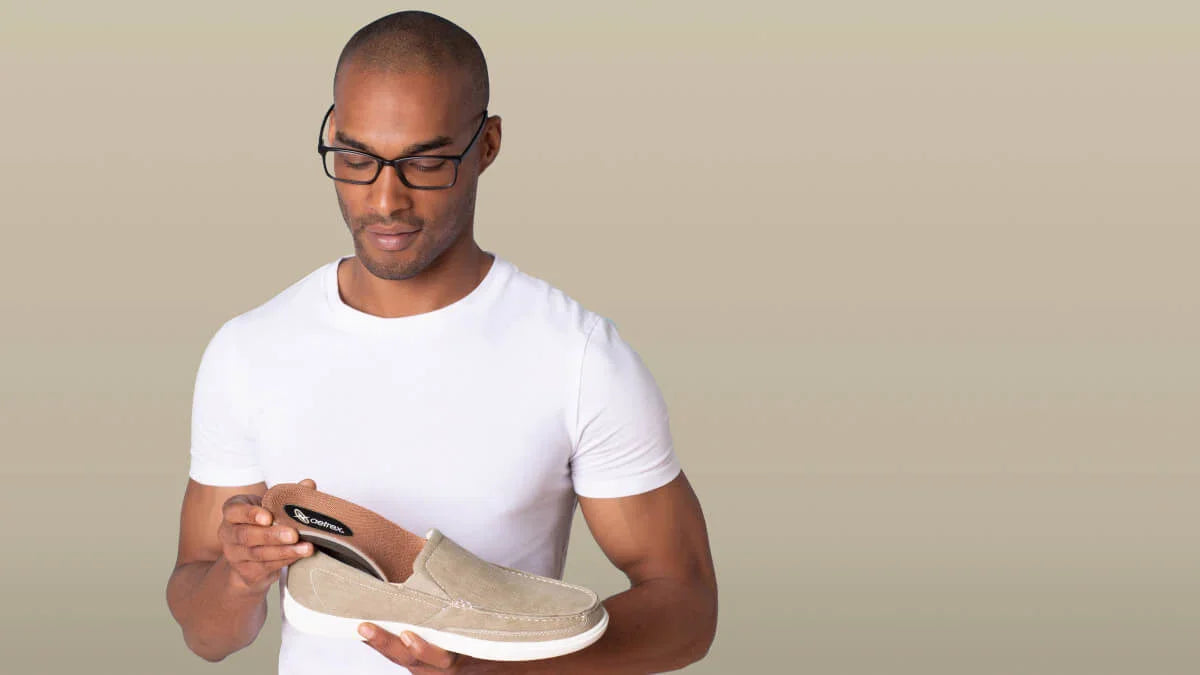We've all dealt with foot pain whether it's from being on our feet all day or from ill-fitting shoes. Foot pain is a common problem today because our feet were originally designed to walk barefoot on soft, uneven surfaces such as dirt, sand, and grass. Today, we mostly walk on hard surfaces and our feet aren't able to distribute pressure evenly. Here are 5 simple ways to help prevent foot pain and discomfort.
1. Insert Aetrex Orthotics inside your shoes
Many shoes do not offer proper support for your feet. Even though some come with an insole, most of the time the insoles are made out of thin & mediocre foam that offer little to no support. Some brands even use hard plastics that restrict natural foot movement which isn't a healthy long-term choice.
Aetrex Orthotics have built-in arch support that helps transfer pressure away from high-pressure areas and creates an equal distribution of pressure as we walk or run.
Aetrex Orthotics:
- Have built-in arch support
- Are designed with premium materials
- Promote natural foot movement
- Are a healthy choice for your feet
2. Avoid Ill-Fitting Shoes
Unsupportive shoes can cause foot conditions such as bunions, blisters, calluses, and ingrown toenails. The most common type of shoes that cause foot pain are high heels; especially ones with a narrow toe box and heel. Choosing shoes that support your feet is critical in alleviating discomfort.
- Choose shoes with arch support
- Choose shoes with a generous toe box area
- Make sure you wear the correct shoe size
- Avoid shoes with a lack of arch support & cushioning
- Avoid shoes with a narrow heel
All Aetrex Shoes have arch support either built into the shoe or with a removable insole. Arch support helps relieve common foot pains like plantar fasciitis, heel pain, and arch pain. Depending on the style, here is a list of comfort features that can be found in Aetrex shoes.
Aetrex Shoe Features:
- Supportive arch
- Superior cushioning
- Adjustable straps, stretchy gore, and laces
- A firm, but flexible midsole
- Met bar pod
- Bunion pockets
- Padded heel
- Dual-density outsole
3. Stretch Your Feet
Stretching your feet will keep your feet strong and help reduce foot and ankle pain.
Ball Roll: Sit up straight in a chair maintaining proper posture and place a tennis ball on the floor near your foot. Put your foot on top of the tennis ball and roll the ball up and down. Use the ball to massage the bottom of your foot for 3-5 minutes. You can increase or decrease the pressure on the tennis ball as needed.

4. Use Hot & Cold Treatments
The use of hot and cold therapies can help reduce pain and relieve swelling and inflammation. Soaking feet in warm water or applying ice packs can help relieve discomfort.


5. Maintain a Healthy Weight
Our feet support the entire weight of the body; therefore, any excessive weight gain can cause decreased blood circulation and inflammation. The additional weight gain puts added pressure on the feet during the gait process and can increase the mechanical stress applied to the feet, increasing the risk of pain. Maintaining an active and healthy lifestyle is important to your overall health.


Share:
Comfort Features: Aetrex Signature Arch Support
This Is Why the Maui Orthotic Flips are the #1 Choice for Comfort